Comprehensive Report: International Accounting Standards Convergence
VerifiedAdded on 2019/12/03
|8
|2612
|136
Report
AI Summary
This report provides a comprehensive overview of the convergence of international accounting standards, focusing on the collaborative efforts of the International Accounting Standards Board (IASB) and the Financial Accounting Standards Board (FASB). The report details the objectives of convergence, which include establishing common accounting standards to enhance comparability, reliability, understanding, and relevancy of financial statements. It discusses the progress made, including the Norwalk Agreement, memorandum of understanding, and the adoption of IFRS by numerous jurisdictions. The report also addresses the challenges and criticisms associated with convergence, such as the cost and pace of implementation. Key areas like revenue recognition, financial instruments, and lease accounting are examined, highlighting the complexities and progress in these areas. The report concludes by emphasizing the ongoing efforts to improve global financial reporting, despite the obstacles encountered. It also covers the impact of convergence on various stakeholders, including companies, investors, auditors, and regulatory bodies, and stresses the importance of international cooperation in achieving greater consistency in accounting standards. The report highlights that while a 'one-size-fits-all' model may not be perfect, ongoing efforts and network effects are driving progress towards quasi-convergence, ultimately improving financial reporting globally.
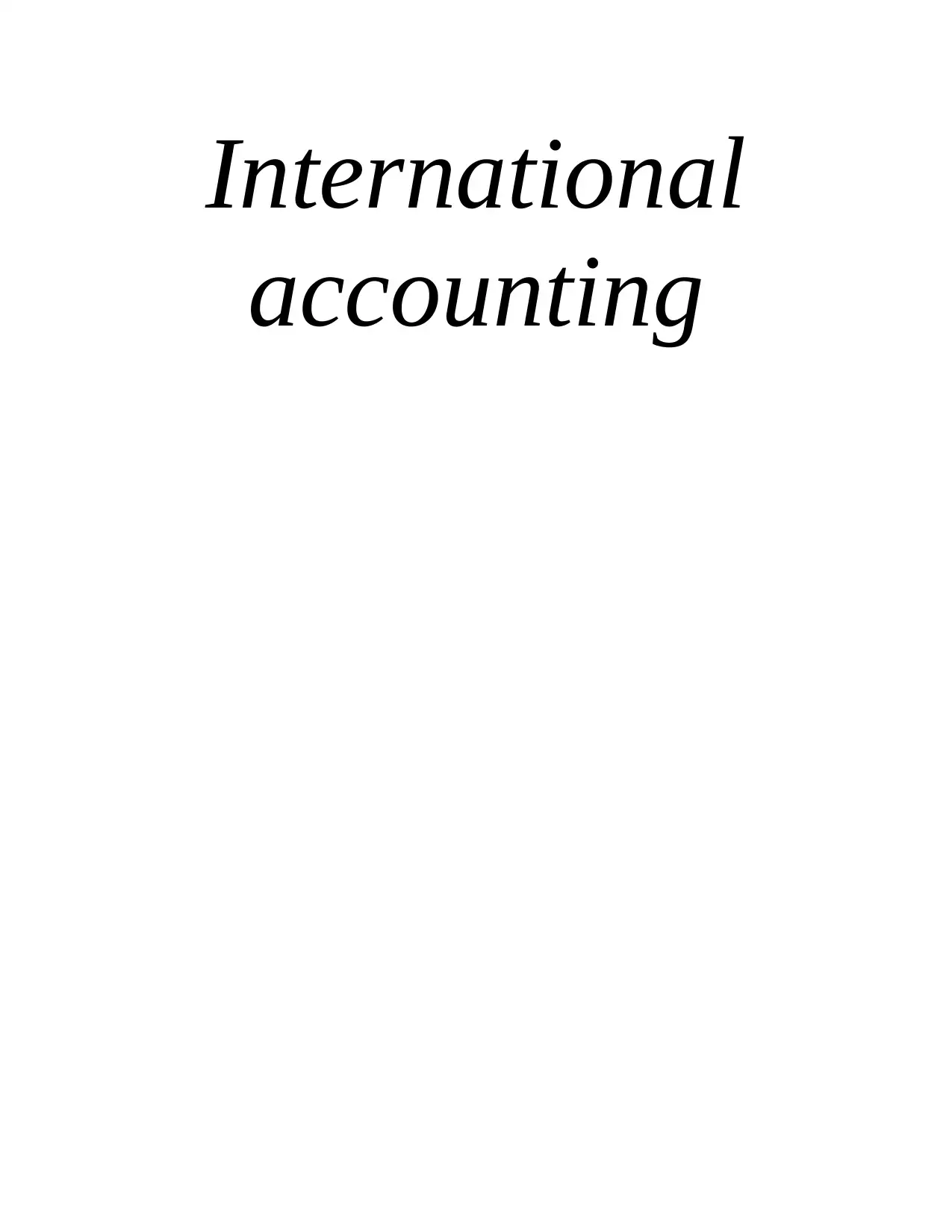
International
accounting
accounting
Paraphrase This Document
Need a fresh take? Get an instant paraphrase of this document with our AI Paraphraser
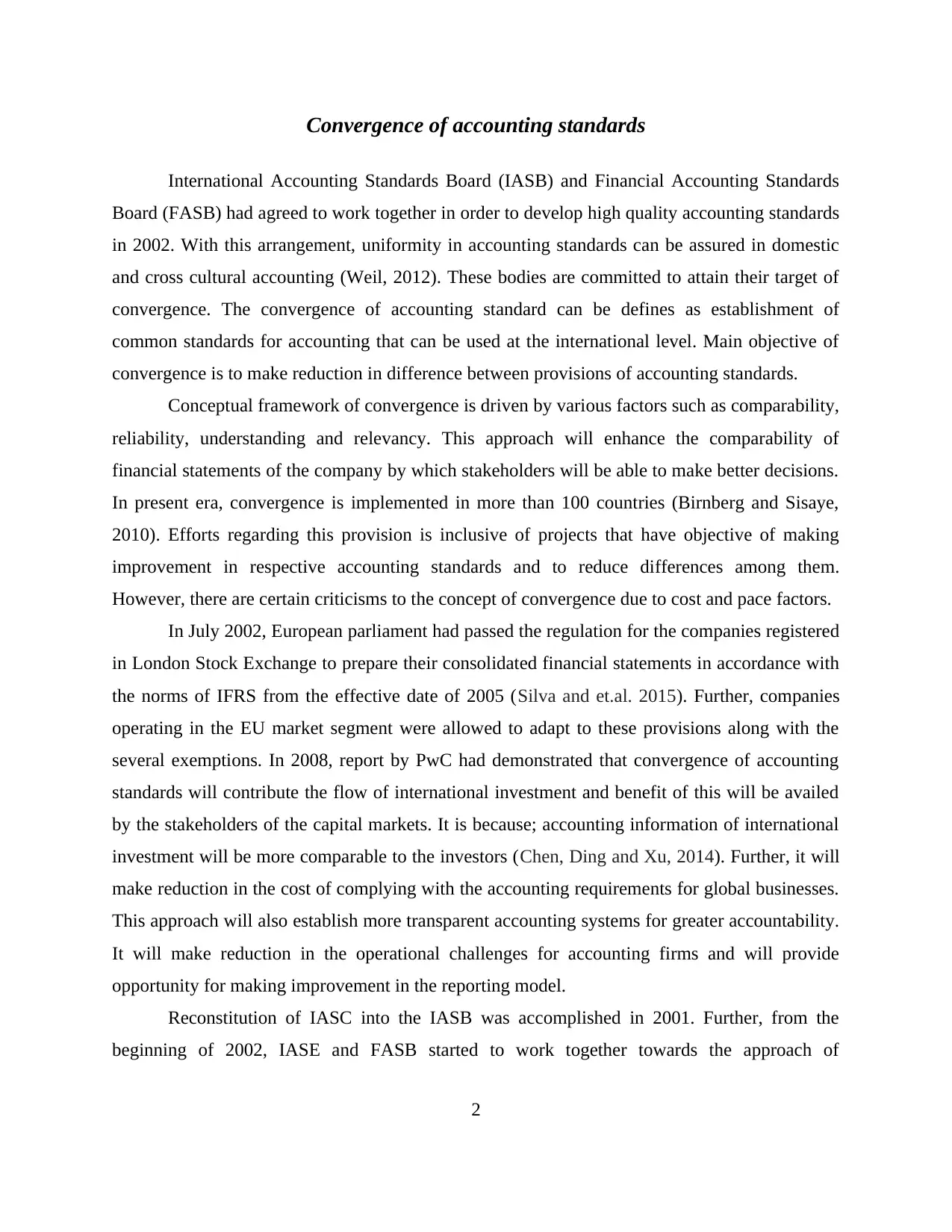
Convergence of accounting standards
International Accounting Standards Board (IASB) and Financial Accounting Standards
Board (FASB) had agreed to work together in order to develop high quality accounting standards
in 2002. With this arrangement, uniformity in accounting standards can be assured in domestic
and cross cultural accounting (Weil, 2012). These bodies are committed to attain their target of
convergence. The convergence of accounting standard can be defines as establishment of
common standards for accounting that can be used at the international level. Main objective of
convergence is to make reduction in difference between provisions of accounting standards.
Conceptual framework of convergence is driven by various factors such as comparability,
reliability, understanding and relevancy. This approach will enhance the comparability of
financial statements of the company by which stakeholders will be able to make better decisions.
In present era, convergence is implemented in more than 100 countries (Birnberg and Sisaye,
2010). Efforts regarding this provision is inclusive of projects that have objective of making
improvement in respective accounting standards and to reduce differences among them.
However, there are certain criticisms to the concept of convergence due to cost and pace factors.
In July 2002, European parliament had passed the regulation for the companies registered
in London Stock Exchange to prepare their consolidated financial statements in accordance with
the norms of IFRS from the effective date of 2005 (Silva and et.al. 2015). Further, companies
operating in the EU market segment were allowed to adapt to these provisions along with the
several exemptions. In 2008, report by PwC had demonstrated that convergence of accounting
standards will contribute the flow of international investment and benefit of this will be availed
by the stakeholders of the capital markets. It is because; accounting information of international
investment will be more comparable to the investors (Chen, Ding and Xu, 2014). Further, it will
make reduction in the cost of complying with the accounting requirements for global businesses.
This approach will also establish more transparent accounting systems for greater accountability.
It will make reduction in the operational challenges for accounting firms and will provide
opportunity for making improvement in the reporting model.
Reconstitution of IASC into the IASB was accomplished in 2001. Further, from the
beginning of 2002, IASE and FASB started to work together towards the approach of
2
International Accounting Standards Board (IASB) and Financial Accounting Standards
Board (FASB) had agreed to work together in order to develop high quality accounting standards
in 2002. With this arrangement, uniformity in accounting standards can be assured in domestic
and cross cultural accounting (Weil, 2012). These bodies are committed to attain their target of
convergence. The convergence of accounting standard can be defines as establishment of
common standards for accounting that can be used at the international level. Main objective of
convergence is to make reduction in difference between provisions of accounting standards.
Conceptual framework of convergence is driven by various factors such as comparability,
reliability, understanding and relevancy. This approach will enhance the comparability of
financial statements of the company by which stakeholders will be able to make better decisions.
In present era, convergence is implemented in more than 100 countries (Birnberg and Sisaye,
2010). Efforts regarding this provision is inclusive of projects that have objective of making
improvement in respective accounting standards and to reduce differences among them.
However, there are certain criticisms to the concept of convergence due to cost and pace factors.
In July 2002, European parliament had passed the regulation for the companies registered
in London Stock Exchange to prepare their consolidated financial statements in accordance with
the norms of IFRS from the effective date of 2005 (Silva and et.al. 2015). Further, companies
operating in the EU market segment were allowed to adapt to these provisions along with the
several exemptions. In 2008, report by PwC had demonstrated that convergence of accounting
standards will contribute the flow of international investment and benefit of this will be availed
by the stakeholders of the capital markets. It is because; accounting information of international
investment will be more comparable to the investors (Chen, Ding and Xu, 2014). Further, it will
make reduction in the cost of complying with the accounting requirements for global businesses.
This approach will also establish more transparent accounting systems for greater accountability.
It will make reduction in the operational challenges for accounting firms and will provide
opportunity for making improvement in the reporting model.
Reconstitution of IASC into the IASB was accomplished in 2001. Further, from the
beginning of 2002, IASE and FASB started to work together towards the approach of
2
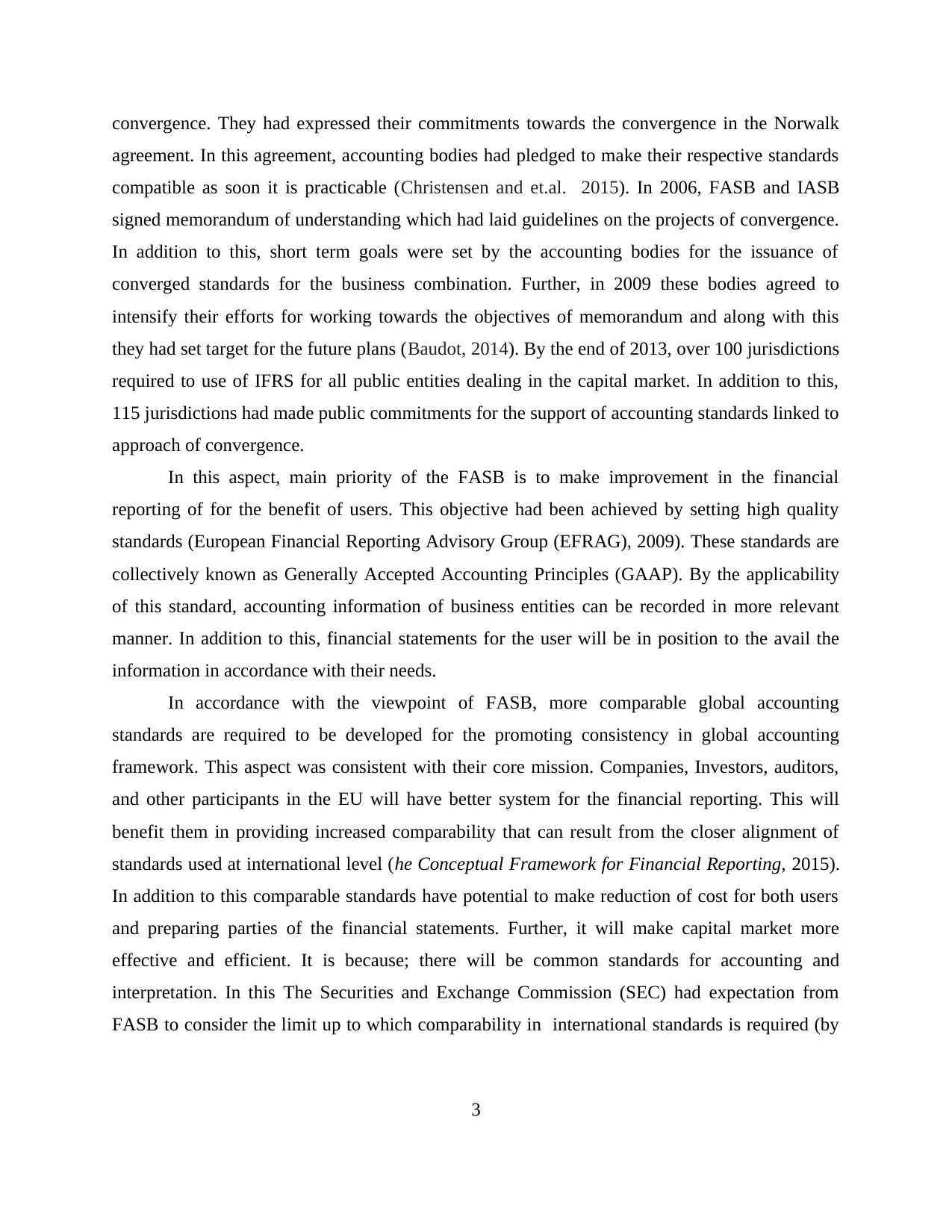
convergence. They had expressed their commitments towards the convergence in the Norwalk
agreement. In this agreement, accounting bodies had pledged to make their respective standards
compatible as soon it is practicable (Christensen and et.al. 2015). In 2006, FASB and IASB
signed memorandum of understanding which had laid guidelines on the projects of convergence.
In addition to this, short term goals were set by the accounting bodies for the issuance of
converged standards for the business combination. Further, in 2009 these bodies agreed to
intensify their efforts for working towards the objectives of memorandum and along with this
they had set target for the future plans (Baudot, 2014). By the end of 2013, over 100 jurisdictions
required to use of IFRS for all public entities dealing in the capital market. In addition to this,
115 jurisdictions had made public commitments for the support of accounting standards linked to
approach of convergence.
In this aspect, main priority of the FASB is to make improvement in the financial
reporting of for the benefit of users. This objective had been achieved by setting high quality
standards (European Financial Reporting Advisory Group (EFRAG), 2009). These standards are
collectively known as Generally Accepted Accounting Principles (GAAP). By the applicability
of this standard, accounting information of business entities can be recorded in more relevant
manner. In addition to this, financial statements for the user will be in position to the avail the
information in accordance with their needs.
In accordance with the viewpoint of FASB, more comparable global accounting
standards are required to be developed for the promoting consistency in global accounting
framework. This aspect was consistent with their core mission. Companies, Investors, auditors,
and other participants in the EU will have better system for the financial reporting. This will
benefit them in providing increased comparability that can result from the closer alignment of
standards used at international level (he Conceptual Framework for Financial Reporting, 2015).
In addition to this comparable standards have potential to make reduction of cost for both users
and preparing parties of the financial statements. Further, it will make capital market more
effective and efficient. It is because; there will be common standards for accounting and
interpretation. In this The Securities and Exchange Commission (SEC) had expectation from
FASB to consider the limit up to which comparability in international standards is required (by
3
agreement. In this agreement, accounting bodies had pledged to make their respective standards
compatible as soon it is practicable (Christensen and et.al. 2015). In 2006, FASB and IASB
signed memorandum of understanding which had laid guidelines on the projects of convergence.
In addition to this, short term goals were set by the accounting bodies for the issuance of
converged standards for the business combination. Further, in 2009 these bodies agreed to
intensify their efforts for working towards the objectives of memorandum and along with this
they had set target for the future plans (Baudot, 2014). By the end of 2013, over 100 jurisdictions
required to use of IFRS for all public entities dealing in the capital market. In addition to this,
115 jurisdictions had made public commitments for the support of accounting standards linked to
approach of convergence.
In this aspect, main priority of the FASB is to make improvement in the financial
reporting of for the benefit of users. This objective had been achieved by setting high quality
standards (European Financial Reporting Advisory Group (EFRAG), 2009). These standards are
collectively known as Generally Accepted Accounting Principles (GAAP). By the applicability
of this standard, accounting information of business entities can be recorded in more relevant
manner. In addition to this, financial statements for the user will be in position to the avail the
information in accordance with their needs.
In accordance with the viewpoint of FASB, more comparable global accounting
standards are required to be developed for the promoting consistency in global accounting
framework. This aspect was consistent with their core mission. Companies, Investors, auditors,
and other participants in the EU will have better system for the financial reporting. This will
benefit them in providing increased comparability that can result from the closer alignment of
standards used at international level (he Conceptual Framework for Financial Reporting, 2015).
In addition to this comparable standards have potential to make reduction of cost for both users
and preparing parties of the financial statements. Further, it will make capital market more
effective and efficient. It is because; there will be common standards for accounting and
interpretation. In this The Securities and Exchange Commission (SEC) had expectation from
FASB to consider the limit up to which comparability in international standards is required (by
3
⊘ This is a preview!⊘
Do you want full access?
Subscribe today to unlock all pages.

Trusted by 1+ million students worldwide
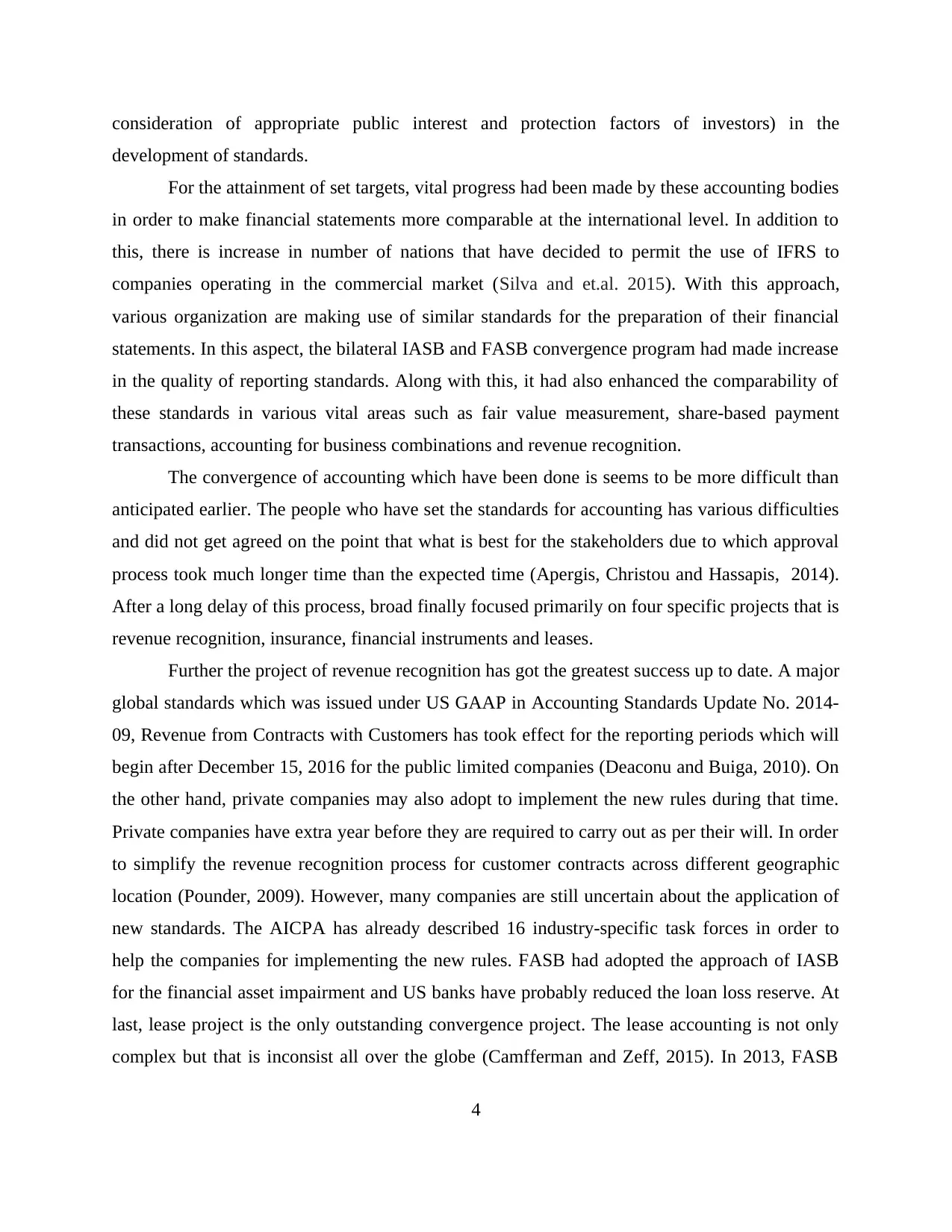
consideration of appropriate public interest and protection factors of investors) in the
development of standards.
For the attainment of set targets, vital progress had been made by these accounting bodies
in order to make financial statements more comparable at the international level. In addition to
this, there is increase in number of nations that have decided to permit the use of IFRS to
companies operating in the commercial market (Silva and et.al. 2015). With this approach,
various organization are making use of similar standards for the preparation of their financial
statements. In this aspect, the bilateral IASB and FASB convergence program had made increase
in the quality of reporting standards. Along with this, it had also enhanced the comparability of
these standards in various vital areas such as fair value measurement, share-based payment
transactions, accounting for business combinations and revenue recognition.
The convergence of accounting which have been done is seems to be more difficult than
anticipated earlier. The people who have set the standards for accounting has various difficulties
and did not get agreed on the point that what is best for the stakeholders due to which approval
process took much longer time than the expected time (Apergis, Christou and Hassapis, 2014).
After a long delay of this process, broad finally focused primarily on four specific projects that is
revenue recognition, insurance, financial instruments and leases.
Further the project of revenue recognition has got the greatest success up to date. A major
global standards which was issued under US GAAP in Accounting Standards Update No. 2014-
09, Revenue from Contracts with Customers has took effect for the reporting periods which will
begin after December 15, 2016 for the public limited companies (Deaconu and Buiga, 2010). On
the other hand, private companies may also adopt to implement the new rules during that time.
Private companies have extra year before they are required to carry out as per their will. In order
to simplify the revenue recognition process for customer contracts across different geographic
location (Pounder, 2009). However, many companies are still uncertain about the application of
new standards. The AICPA has already described 16 industry-specific task forces in order to
help the companies for implementing the new rules. FASB had adopted the approach of IASB
for the financial asset impairment and US banks have probably reduced the loan loss reserve. At
last, lease project is the only outstanding convergence project. The lease accounting is not only
complex but that is inconsist all over the globe (Camfferman and Zeff, 2015). In 2013, FASB
4
development of standards.
For the attainment of set targets, vital progress had been made by these accounting bodies
in order to make financial statements more comparable at the international level. In addition to
this, there is increase in number of nations that have decided to permit the use of IFRS to
companies operating in the commercial market (Silva and et.al. 2015). With this approach,
various organization are making use of similar standards for the preparation of their financial
statements. In this aspect, the bilateral IASB and FASB convergence program had made increase
in the quality of reporting standards. Along with this, it had also enhanced the comparability of
these standards in various vital areas such as fair value measurement, share-based payment
transactions, accounting for business combinations and revenue recognition.
The convergence of accounting which have been done is seems to be more difficult than
anticipated earlier. The people who have set the standards for accounting has various difficulties
and did not get agreed on the point that what is best for the stakeholders due to which approval
process took much longer time than the expected time (Apergis, Christou and Hassapis, 2014).
After a long delay of this process, broad finally focused primarily on four specific projects that is
revenue recognition, insurance, financial instruments and leases.
Further the project of revenue recognition has got the greatest success up to date. A major
global standards which was issued under US GAAP in Accounting Standards Update No. 2014-
09, Revenue from Contracts with Customers has took effect for the reporting periods which will
begin after December 15, 2016 for the public limited companies (Deaconu and Buiga, 2010). On
the other hand, private companies may also adopt to implement the new rules during that time.
Private companies have extra year before they are required to carry out as per their will. In order
to simplify the revenue recognition process for customer contracts across different geographic
location (Pounder, 2009). However, many companies are still uncertain about the application of
new standards. The AICPA has already described 16 industry-specific task forces in order to
help the companies for implementing the new rules. FASB had adopted the approach of IASB
for the financial asset impairment and US banks have probably reduced the loan loss reserve. At
last, lease project is the only outstanding convergence project. The lease accounting is not only
complex but that is inconsist all over the globe (Camfferman and Zeff, 2015). In 2013, FASB
4
Paraphrase This Document
Need a fresh take? Get an instant paraphrase of this document with our AI Paraphraser
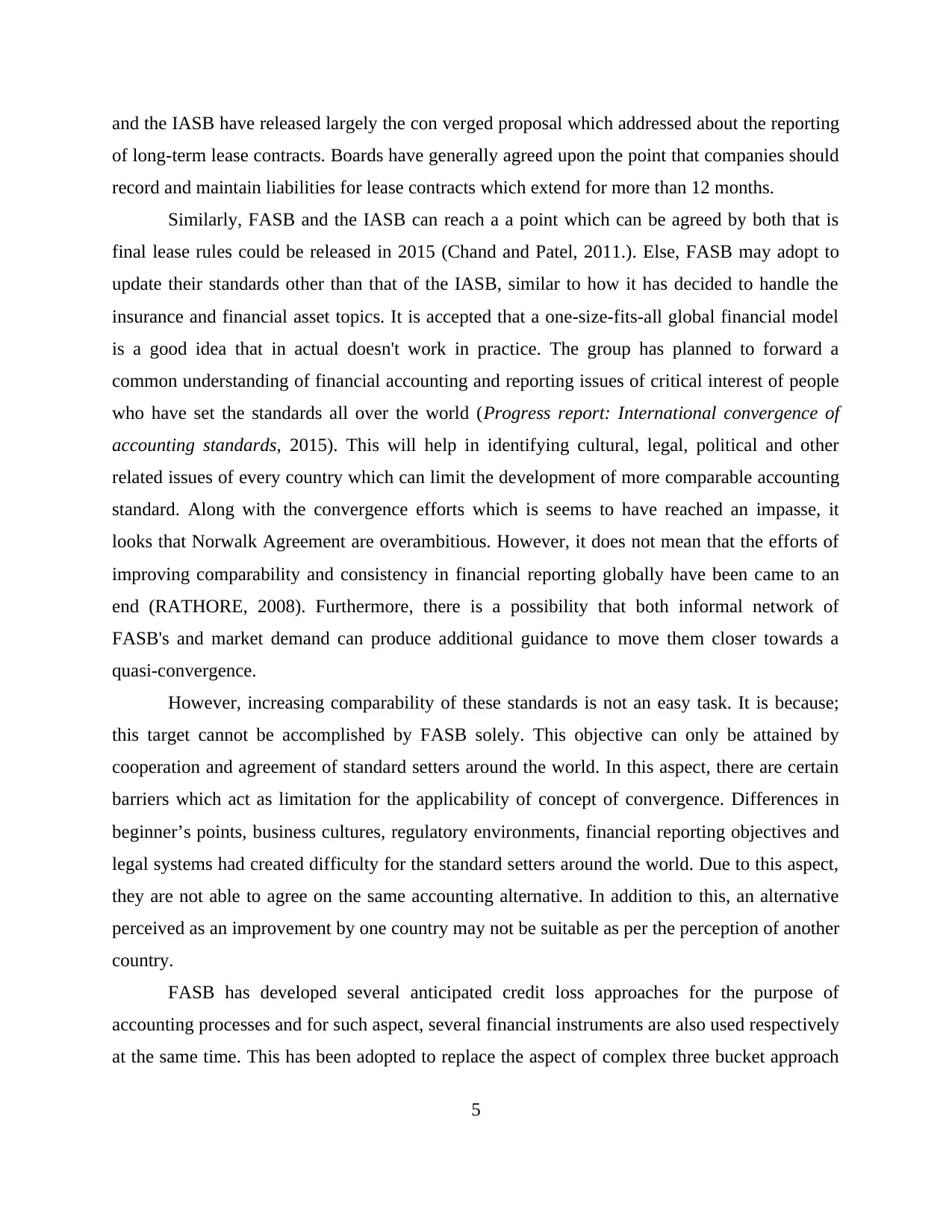
and the IASB have released largely the con verged proposal which addressed about the reporting
of long-term lease contracts. Boards have generally agreed upon the point that companies should
record and maintain liabilities for lease contracts which extend for more than 12 months.
Similarly, FASB and the IASB can reach a a point which can be agreed by both that is
final lease rules could be released in 2015 (Chand and Patel, 2011.). Else, FASB may adopt to
update their standards other than that of the IASB, similar to how it has decided to handle the
insurance and financial asset topics. It is accepted that a one-size-fits-all global financial model
is a good idea that in actual doesn't work in practice. The group has planned to forward a
common understanding of financial accounting and reporting issues of critical interest of people
who have set the standards all over the world (Progress report: International convergence of
accounting standards, 2015). This will help in identifying cultural, legal, political and other
related issues of every country which can limit the development of more comparable accounting
standard. Along with the convergence efforts which is seems to have reached an impasse, it
looks that Norwalk Agreement are overambitious. However, it does not mean that the efforts of
improving comparability and consistency in financial reporting globally have been came to an
end (RATHORE, 2008). Furthermore, there is a possibility that both informal network of
FASB's and market demand can produce additional guidance to move them closer towards a
quasi-convergence.
However, increasing comparability of these standards is not an easy task. It is because;
this target cannot be accomplished by FASB solely. This objective can only be attained by
cooperation and agreement of standard setters around the world. In this aspect, there are certain
barriers which act as limitation for the applicability of concept of convergence. Differences in
beginner’s points, business cultures, regulatory environments, financial reporting objectives and
legal systems had created difficulty for the standard setters around the world. Due to this aspect,
they are not able to agree on the same accounting alternative. In addition to this, an alternative
perceived as an improvement by one country may not be suitable as per the perception of another
country.
FASB has developed several anticipated credit loss approaches for the purpose of
accounting processes and for such aspect, several financial instruments are also used respectively
at the same time. This has been adopted to replace the aspect of complex three bucket approach
5
of long-term lease contracts. Boards have generally agreed upon the point that companies should
record and maintain liabilities for lease contracts which extend for more than 12 months.
Similarly, FASB and the IASB can reach a a point which can be agreed by both that is
final lease rules could be released in 2015 (Chand and Patel, 2011.). Else, FASB may adopt to
update their standards other than that of the IASB, similar to how it has decided to handle the
insurance and financial asset topics. It is accepted that a one-size-fits-all global financial model
is a good idea that in actual doesn't work in practice. The group has planned to forward a
common understanding of financial accounting and reporting issues of critical interest of people
who have set the standards all over the world (Progress report: International convergence of
accounting standards, 2015). This will help in identifying cultural, legal, political and other
related issues of every country which can limit the development of more comparable accounting
standard. Along with the convergence efforts which is seems to have reached an impasse, it
looks that Norwalk Agreement are overambitious. However, it does not mean that the efforts of
improving comparability and consistency in financial reporting globally have been came to an
end (RATHORE, 2008). Furthermore, there is a possibility that both informal network of
FASB's and market demand can produce additional guidance to move them closer towards a
quasi-convergence.
However, increasing comparability of these standards is not an easy task. It is because;
this target cannot be accomplished by FASB solely. This objective can only be attained by
cooperation and agreement of standard setters around the world. In this aspect, there are certain
barriers which act as limitation for the applicability of concept of convergence. Differences in
beginner’s points, business cultures, regulatory environments, financial reporting objectives and
legal systems had created difficulty for the standard setters around the world. Due to this aspect,
they are not able to agree on the same accounting alternative. In addition to this, an alternative
perceived as an improvement by one country may not be suitable as per the perception of another
country.
FASB has developed several anticipated credit loss approaches for the purpose of
accounting processes and for such aspect, several financial instruments are also used respectively
at the same time. This has been adopted to replace the aspect of complex three bucket approach
5
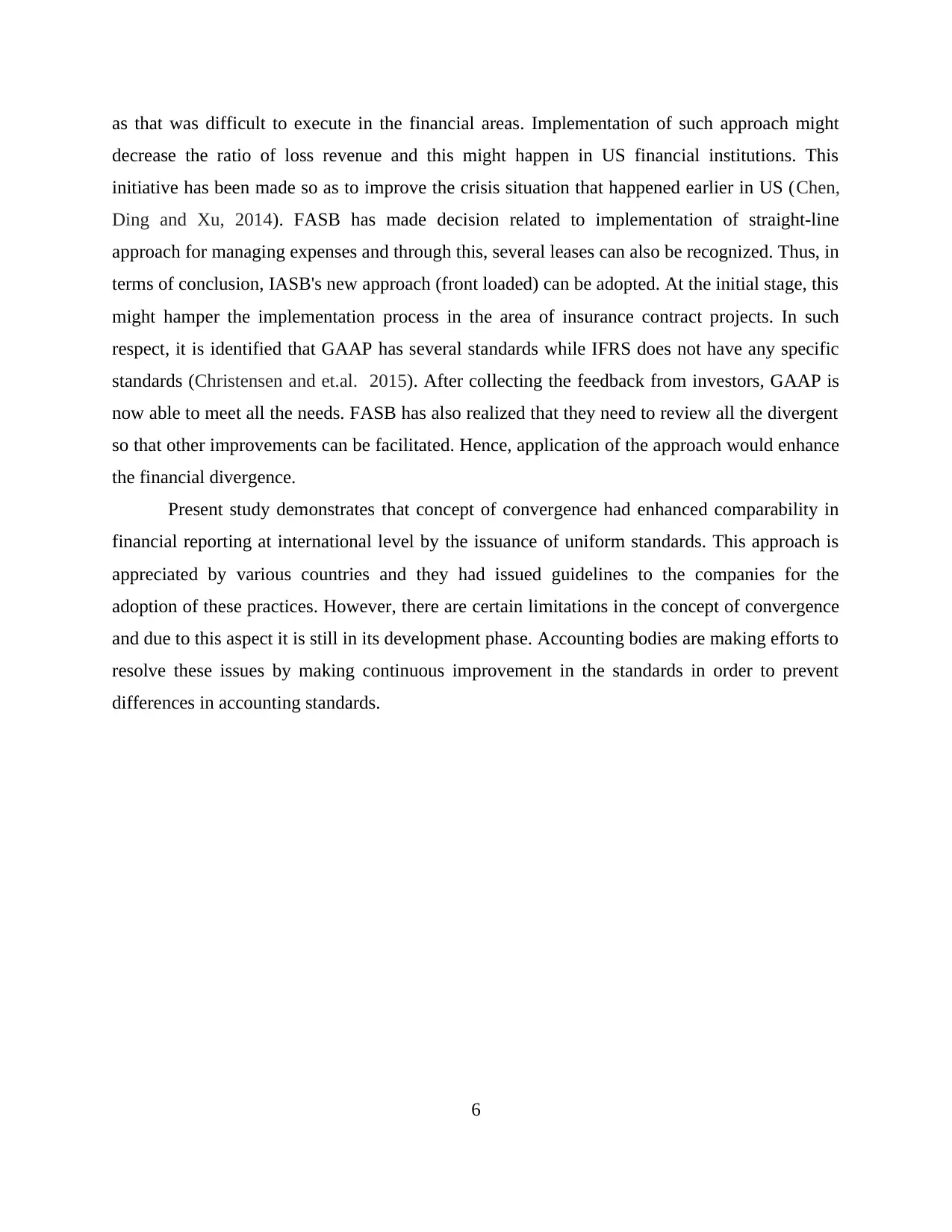
as that was difficult to execute in the financial areas. Implementation of such approach might
decrease the ratio of loss revenue and this might happen in US financial institutions. This
initiative has been made so as to improve the crisis situation that happened earlier in US (Chen,
Ding and Xu, 2014). FASB has made decision related to implementation of straight-line
approach for managing expenses and through this, several leases can also be recognized. Thus, in
terms of conclusion, IASB's new approach (front loaded) can be adopted. At the initial stage, this
might hamper the implementation process in the area of insurance contract projects. In such
respect, it is identified that GAAP has several standards while IFRS does not have any specific
standards (Christensen and et.al. 2015). After collecting the feedback from investors, GAAP is
now able to meet all the needs. FASB has also realized that they need to review all the divergent
so that other improvements can be facilitated. Hence, application of the approach would enhance
the financial divergence.
Present study demonstrates that concept of convergence had enhanced comparability in
financial reporting at international level by the issuance of uniform standards. This approach is
appreciated by various countries and they had issued guidelines to the companies for the
adoption of these practices. However, there are certain limitations in the concept of convergence
and due to this aspect it is still in its development phase. Accounting bodies are making efforts to
resolve these issues by making continuous improvement in the standards in order to prevent
differences in accounting standards.
6
decrease the ratio of loss revenue and this might happen in US financial institutions. This
initiative has been made so as to improve the crisis situation that happened earlier in US (Chen,
Ding and Xu, 2014). FASB has made decision related to implementation of straight-line
approach for managing expenses and through this, several leases can also be recognized. Thus, in
terms of conclusion, IASB's new approach (front loaded) can be adopted. At the initial stage, this
might hamper the implementation process in the area of insurance contract projects. In such
respect, it is identified that GAAP has several standards while IFRS does not have any specific
standards (Christensen and et.al. 2015). After collecting the feedback from investors, GAAP is
now able to meet all the needs. FASB has also realized that they need to review all the divergent
so that other improvements can be facilitated. Hence, application of the approach would enhance
the financial divergence.
Present study demonstrates that concept of convergence had enhanced comparability in
financial reporting at international level by the issuance of uniform standards. This approach is
appreciated by various countries and they had issued guidelines to the companies for the
adoption of these practices. However, there are certain limitations in the concept of convergence
and due to this aspect it is still in its development phase. Accounting bodies are making efforts to
resolve these issues by making continuous improvement in the standards in order to prevent
differences in accounting standards.
6
⊘ This is a preview!⊘
Do you want full access?
Subscribe today to unlock all pages.

Trusted by 1+ million students worldwide
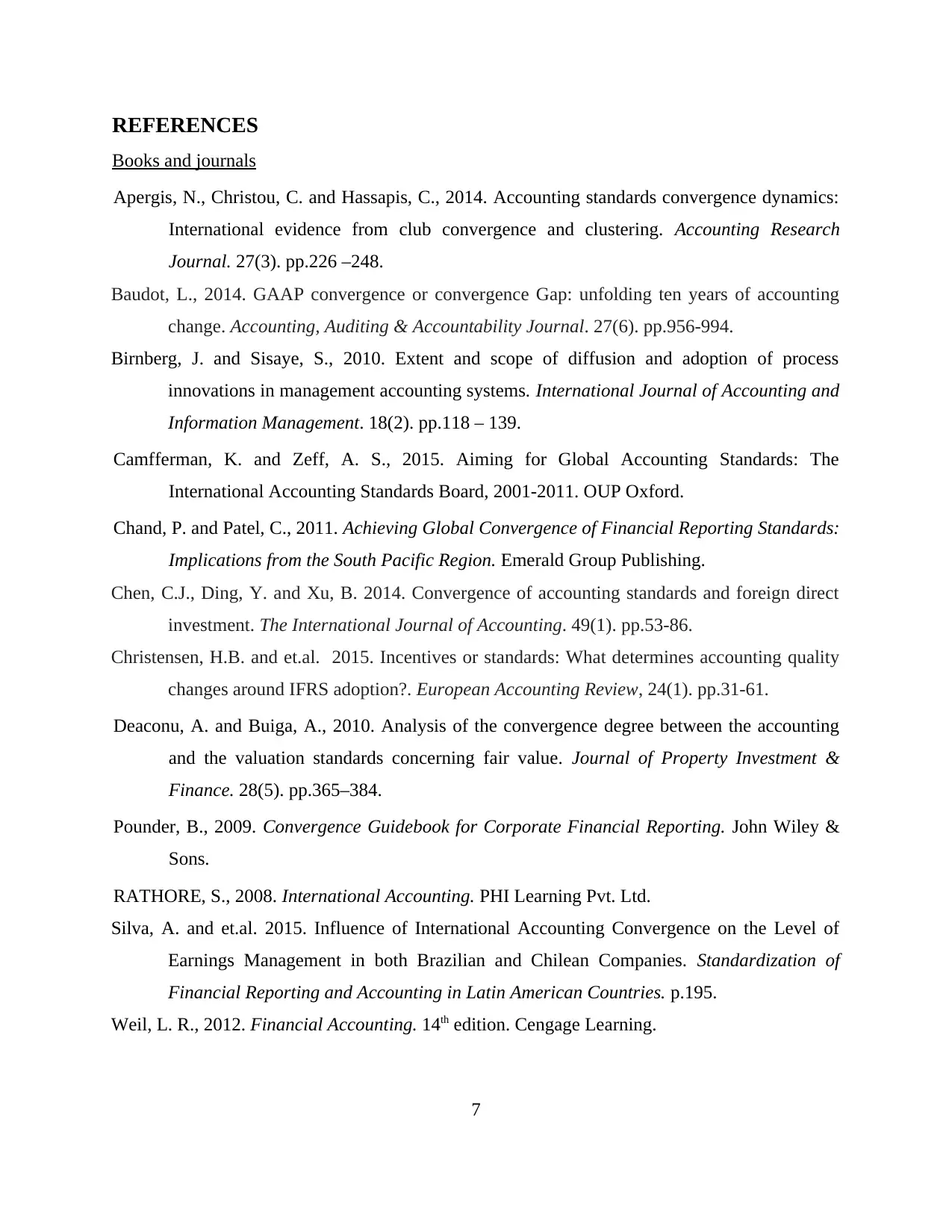
REFERENCES
Books and journals
Apergis, N., Christou, C. and Hassapis, C., 2014. Accounting standards convergence dynamics:
International evidence from club convergence and clustering. Accounting Research
Journal. 27(3). pp.226 –248.
Baudot, L., 2014. GAAP convergence or convergence Gap: unfolding ten years of accounting
change. Accounting, Auditing & Accountability Journal. 27(6). pp.956-994.
Birnberg, J. and Sisaye, S., 2010. Extent and scope of diffusion and adoption of process
innovations in management accounting systems. International Journal of Accounting and
Information Management. 18(2). pp.118 – 139.
Camfferman, K. and Zeff, A. S., 2015. Aiming for Global Accounting Standards: The
International Accounting Standards Board, 2001-2011. OUP Oxford.
Chand, P. and Patel, C., 2011. Achieving Global Convergence of Financial Reporting Standards:
Implications from the South Pacific Region. Emerald Group Publishing.
Chen, C.J., Ding, Y. and Xu, B. 2014. Convergence of accounting standards and foreign direct
investment. The International Journal of Accounting. 49(1). pp.53-86.
Christensen, H.B. and et.al. 2015. Incentives or standards: What determines accounting quality
changes around IFRS adoption?. European Accounting Review, 24(1). pp.31-61.
Deaconu, A. and Buiga, A., 2010. Analysis of the convergence degree between the accounting
and the valuation standards concerning fair value. Journal of Property Investment &
Finance. 28(5). pp.365–384.
Pounder, B., 2009. Convergence Guidebook for Corporate Financial Reporting. John Wiley &
Sons.
RATHORE, S., 2008. International Accounting. PHI Learning Pvt. Ltd.
Silva, A. and et.al. 2015. Influence of International Accounting Convergence on the Level of
Earnings Management in both Brazilian and Chilean Companies. Standardization of
Financial Reporting and Accounting in Latin American Countries. p.195.
Weil, L. R., 2012. Financial Accounting. 14th edition. Cengage Learning.
7
Books and journals
Apergis, N., Christou, C. and Hassapis, C., 2014. Accounting standards convergence dynamics:
International evidence from club convergence and clustering. Accounting Research
Journal. 27(3). pp.226 –248.
Baudot, L., 2014. GAAP convergence or convergence Gap: unfolding ten years of accounting
change. Accounting, Auditing & Accountability Journal. 27(6). pp.956-994.
Birnberg, J. and Sisaye, S., 2010. Extent and scope of diffusion and adoption of process
innovations in management accounting systems. International Journal of Accounting and
Information Management. 18(2). pp.118 – 139.
Camfferman, K. and Zeff, A. S., 2015. Aiming for Global Accounting Standards: The
International Accounting Standards Board, 2001-2011. OUP Oxford.
Chand, P. and Patel, C., 2011. Achieving Global Convergence of Financial Reporting Standards:
Implications from the South Pacific Region. Emerald Group Publishing.
Chen, C.J., Ding, Y. and Xu, B. 2014. Convergence of accounting standards and foreign direct
investment. The International Journal of Accounting. 49(1). pp.53-86.
Christensen, H.B. and et.al. 2015. Incentives or standards: What determines accounting quality
changes around IFRS adoption?. European Accounting Review, 24(1). pp.31-61.
Deaconu, A. and Buiga, A., 2010. Analysis of the convergence degree between the accounting
and the valuation standards concerning fair value. Journal of Property Investment &
Finance. 28(5). pp.365–384.
Pounder, B., 2009. Convergence Guidebook for Corporate Financial Reporting. John Wiley &
Sons.
RATHORE, S., 2008. International Accounting. PHI Learning Pvt. Ltd.
Silva, A. and et.al. 2015. Influence of International Accounting Convergence on the Level of
Earnings Management in both Brazilian and Chilean Companies. Standardization of
Financial Reporting and Accounting in Latin American Countries. p.195.
Weil, L. R., 2012. Financial Accounting. 14th edition. Cengage Learning.
7
Paraphrase This Document
Need a fresh take? Get an instant paraphrase of this document with our AI Paraphraser
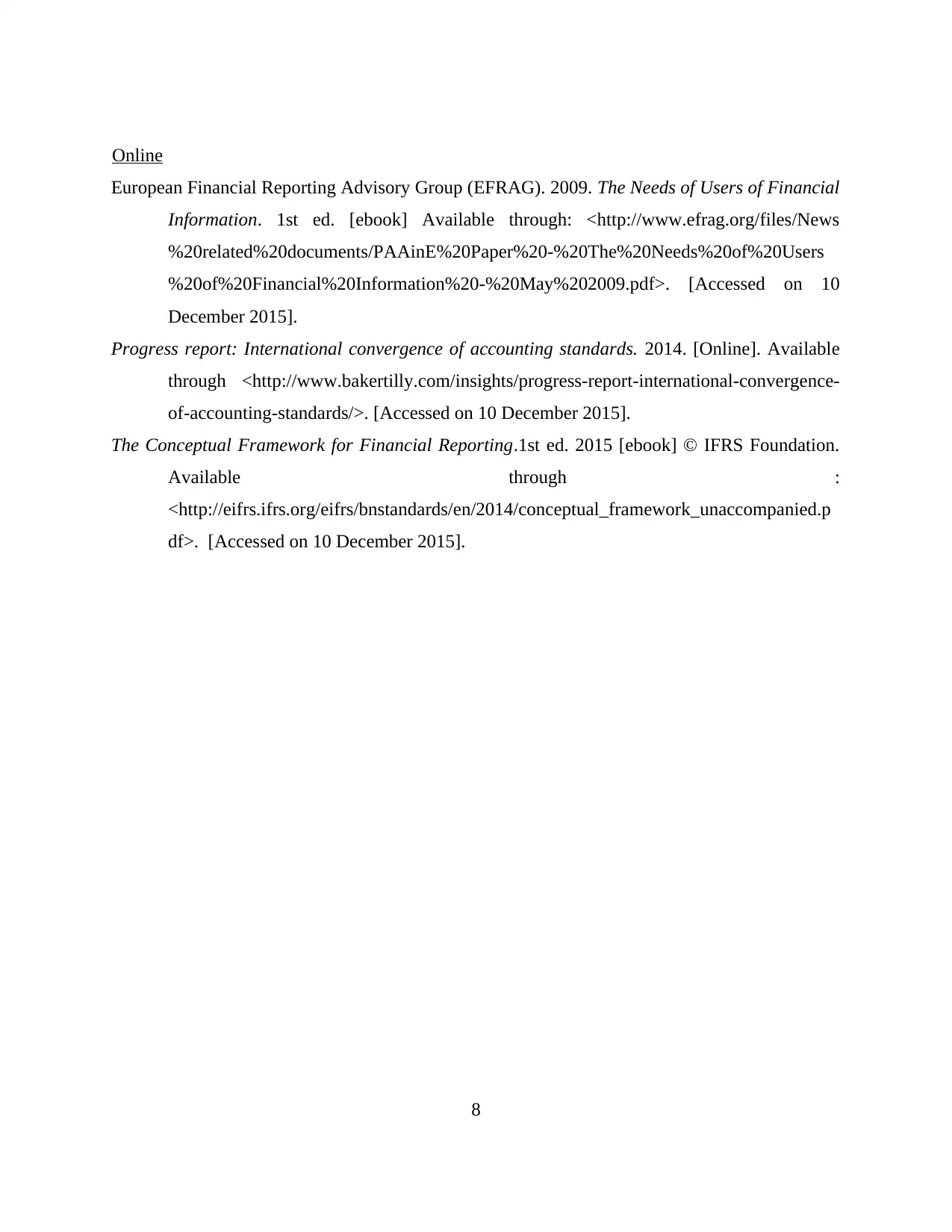
Online
European Financial Reporting Advisory Group (EFRAG). 2009. The Needs of Users of Financial
Information. 1st ed. [ebook] Available through: <http://www.efrag.org/files/News
%20related%20documents/PAAinE%20Paper%20-%20The%20Needs%20of%20Users
%20of%20Financial%20Information%20-%20May%202009.pdf>. [Accessed on 10
December 2015].
Progress report: International convergence of accounting standards. 2014. [Online]. Available
through <http://www.bakertilly.com/insights/progress-report-international-convergence-
of-accounting-standards/>. [Accessed on 10 December 2015].
The Conceptual Framework for Financial Reporting.1st ed. 2015 [ebook] © IFRS Foundation.
Available through :
<http://eifrs.ifrs.org/eifrs/bnstandards/en/2014/conceptual_framework_unaccompanied.p
df>. [Accessed on 10 December 2015].
8
European Financial Reporting Advisory Group (EFRAG). 2009. The Needs of Users of Financial
Information. 1st ed. [ebook] Available through: <http://www.efrag.org/files/News
%20related%20documents/PAAinE%20Paper%20-%20The%20Needs%20of%20Users
%20of%20Financial%20Information%20-%20May%202009.pdf>. [Accessed on 10
December 2015].
Progress report: International convergence of accounting standards. 2014. [Online]. Available
through <http://www.bakertilly.com/insights/progress-report-international-convergence-
of-accounting-standards/>. [Accessed on 10 December 2015].
The Conceptual Framework for Financial Reporting.1st ed. 2015 [ebook] © IFRS Foundation.
Available through :
<http://eifrs.ifrs.org/eifrs/bnstandards/en/2014/conceptual_framework_unaccompanied.p
df>. [Accessed on 10 December 2015].
8
1 out of 8
Related Documents
Your All-in-One AI-Powered Toolkit for Academic Success.
+13062052269
info@desklib.com
Available 24*7 on WhatsApp / Email
![[object Object]](/_next/static/media/star-bottom.7253800d.svg)
Unlock your academic potential
Copyright © 2020–2025 A2Z Services. All Rights Reserved. Developed and managed by ZUCOL.





